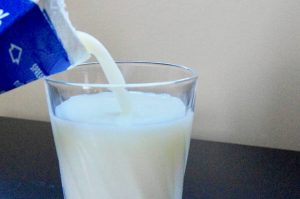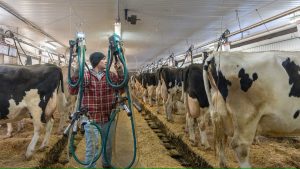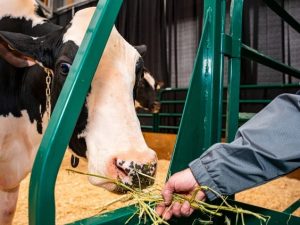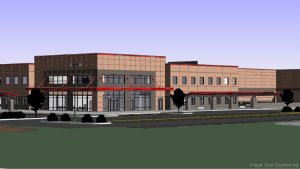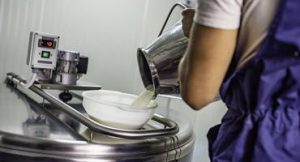
Technology is changing rapidly and although the dairy industry might not be an industrial hotspot for technological advancements, it is moving forward at its own pace. The adoption of new technology on farms is becoming more and more common, with a greater number of farmers implementing new products like robotic systems, automatic feed pushers and body condition cameras. Armed with information generated by these systems, producers are moving towards management practices that favour precision dairy farming. As technology-adoption rates are increasing, and with the development of new and innovative systems, many people have begun to wonder what the dairy industry will look like in a few years’ time.
“I think what I am really interested in,” said Aidan Connolly to attendees of the 2020 American Dairy Science Association’s (ADSA) annual meeting, “is how COVID-19 will impact and influence the interest in adopting new technology in the dairy industry.”
Ironically, the format in which he asked the crowd partially answers the question. This year’s ADSA conference was hosted online. Due to COVID-19, the in-person conference, which was slated to be held in West Palm Beach, Florida, had been cancelled. Instead, the scheduled presenters were asked to pre-record their presentations. The new, online program consisted of more than 800 pre-recorded abstract presentations including 14 live roundtable discussions, and three late-night live informal chat sessions.
Connolly is no newbie to the idea of new technology in dairy. He is the CEO of Cainthus, which develops computer vision and artificial intelligence for dairy farms. Connolly was part of one of several live roundtable discussions that happened each afternoon of the four-day virtual conference. The topic of this roundtable was “Precision Agriculture in the Dairy Industry”, where Connolly and several other dairy-tech experts discussed what the future of the dairy industry might look like.
It felt weird to be sitting behind a computer and scrolling through the list of virtual attendees to find familiar names, instead of scanning the room for familiar faces. What was the same were the innovative discussions and thought-provoking ideas that are always present at global conferences like this.
“What happens if the nutritionist can’t regularly visit on-farm anymore? If vets can’t do on-farm calls? If a new sales rep can’t go from farm to farm to build and develop new contacts?” Connolly questions.
He thinks COVID-19 will help drive precision agriculture forward thanks to the implementation of new technology that will help overcome the roadblocks COVID-19 has put in place.
“Increasingly I think we will be using technology to manage things remotely in a way we never have before. There are the obvious ones like cameras, robots and feeding technology,” he said. But he also wanted to focus on implementing new technology that is less commonly seen on commercial farms. “Things like 3-D printers – so if I don’t want to be shipping parts and having delivery services coming onto my property – these printers would instead allow me to print the parts I need to fix my own devices.”
Dr. Trevor DeVries, a dairy professor at the University of Guelph, whose research often focuses on the implications that on-farm technology has on both cows and producers, agrees that we are likely to see more adoption of technology in the future. “We already are seeing a lot of adoption in the last five to 10 years,” he says. DeVries estimates about 15 per cent of farms in Ontario use robotic milkers.
COVID-19 aside, Dr. DeVries thinks that the main driver for the implementation of new technology will be the desire for lifestyle changes.
“When we look at the reasons for adoption, first and foremost, it’s all about lifestyle,” he said. “It’s about making more time available for producers and allowing them more flexibility in their lifestyles. Of course, technology is also implemented to increase production, improve welfare, and all those things, but those come secondary to the desire for a lifestyle change.”
David Jones, a producer-turned-robotic sales specialist for DeLaval, also agreed with DeVries’ theory that a decreased workload is the main reason for technological adoption.
“From a producer’s perspective, sensor technology is great and the information we get back is incredible, but what we are really focusing on is a workload reduction – so what we look for in technology is something that allows us to do more with less” said Jones. He cautions that sometimes the addition of new technology could be more harmful than beneficial, since it creates yet another system that a producer must learn, maintain and monitor.
“I don’t want sensors that add more work to my workday and more data I have to dig through,” he said.
Dr. Victor Cabrera, a dairy professor from University of Wisconsin-Madison, had a different perspective on data to discuss with the roundtable. “Data will become a commodity – a very important value commodity” he predicted.
However, to properly use the data, systems and programs need to be linked together. “Dairy farms are inundated by data from multiple different streams – from the sensors, from the milk parlour, from genetics, and so forth – and there is a lot of value missing from not connecting all this data together,” he said.
Outside of the roundtable, it was easy to see how the interest in using new technology and data sources influenced many of the research projects presented at the conference. For example, Ivan Campos, a PhD student from the University of Guelph, presented his research, which involved using public weather station data to investigate effects of heat stress on milk production on Ontario dairies.
Data was in no short supply for his study – he used a total of 2.1 million test-day records from 167,620 Ontario cows, as well as temperature and humidity data from nearby weather stations. He identified two temperature humidity index (THI) thresholds that affected milk yields. First, a THI threshold between 64 and 72 that can cause a slow decline in milk yields, and a second, a critical THI threshold of 79, that if exceeded causes a sharp decline in milk yields. This expected reduction in milk yields after a THI of 79 was estimated to be about – 0.40 kilograms per day. Since Ontario summers have an average THI of 69, it is important to be aware of these thresholds when it comes to proactively managing milk production and heat stress within a herd.
Data like the weather may be easy to quantify and measure, but it’s not the only data we should be integrating. Since precision agriculture focuses on individual animals, it’s also important to study data that differentiates cows from one another – such as personality data. This data could help identify which animals are more adaptable to new technologies, such as automatic milking systems (AMS). This is what Anna Schwanke looked at for her Master’s project.
First, she assessed the behaviour of holstein cows after they were exposed to a novel space, human and object. She then used this behaviour to identify five different personality traits in the cattle, and then looked at how these traits impacted how the cows interacted with the AMS.
“Despite there being a lot of knowledge on how to apply precision feeding practices to meet the nutritional requirements of dairy cattle, there is still a lot that we don’t know regarding how personalities of individual cows affect their behavioural requirements,” said Anna Schwanke when explaining the motivation behind her study. “It’s important to know how these behavioural requirements of cows can be managed to ensure their nutritional requirements are being met.”
For example, cows that were identified as having a behavioural characteristic of being fearful of humans had greater meal sizes and needed more AMS fetches, which led to lesser concentrate intake at the AMS and lower milk yield.
“Because of behavioural factors like this, some cows may require more motivation than others to voluntarily visit the AMS,” said Schwanke, “So there is a potential to optimize AMS technology by designing precision feeding strategies to meet both the individual behavioural and physiological requirements of the cows.”
Although robot milking is one of the more popular dairy technologies, there are other tools becoming more common on dairy farms, such as activity monitors. However, research still needs to be done to ensure the data generated by these sensors is being properly utilized.
“The use of precision technology such as activity monitors to detect estrus is increasing in the industry, so it would be useful to know how the health disorders impact the activity of cows” said of Tony Bruinjé of the research he is completing for his PhD in Epidemiology at the University of Guelph.
He found that cows with health disorders had a reduced probability of estrus detection in a breeding system that utilizes activity monitors. He identified three health risk factors in dairy cattle and found that activity monitors only detected estrus in 56 per cent of cows with these risk factors, as opposed to 72 per cent in cows without.
“Such findings can be useful at identifying cows that are less likely to be detected at estrus, so we can refine reproductive management in herds that use activity monitors in their breeding systems,” Bruinjé said.
Steven Larmer, the senior manager of the Genomics Program at Semex, commented during his ADSA presentation that while technology like activity sensors provides us with more data, it is also changing how we share data.
“Producers now have a lot of data available at their fingertips, while previously they had to rely on public recording centres for data and benchmarking,” he said. He believes that because of this, we will see more data staying on-farm and less data flowing into public evaluation systems. “The future will need to adapt to this growing reality, including a shift towards accessing, standardizing and utilizing data from these robotic systems.”
This will be an especially important challenge for the future, as both Larmer and Dr. DeVries believe that adoption rates in Ontario are only beginning to climb. DeVries also predicted these systems may become more affordable in the future, making them even more attractive to producers.
“Obviously the price of implementing new tech on farms is one of the biggest roadblocks for adoption. But as we see adoption rates go up, hopefully we will also see a movement on the pricing side to make some of these technologies more affordable.” He thinks the implementation of technology and data into our systems will really help dairy producers start to manage cows individually.
“Cows aren’t all the same, yet we tend to manage them all as a herd. So we have such great opportunities with automation to manage cows more individually – allowing us to not only meet their nutritional requirements, but also their behavioural needs as well.”








